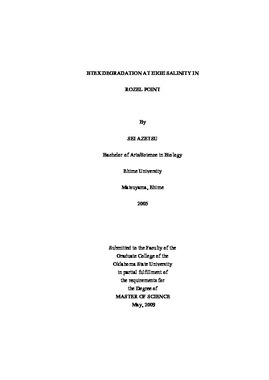| dc.contributor.advisor | Fathepure, Babu Z. | |
| dc.contributor.author | Azetsu, Sei | |
| dc.date.accessioned | 2014-04-15T20:25:24Z | |
| dc.date.available | 2014-04-15T20:25:24Z | |
| dc.date.issued | 2009-05-01 | |
| dc.identifier.uri | https://hdl.handle.net/11244/8900 | |
| dc.description.abstract | Rozel Point is a unique habitat since it is highly saline and also contaminated with high levels crude oil from natural seeps. Unfortunately, very few studies were carried out to understand microbial diversity and their capacity to degrade petroleum compounds at Rozel Point. While halophiles have been shown to degrade aliphatic, aromatic, and poly aromatic compounds, little is known about the fate of benzene, toluene, ethylbenzene, and xylenes (BTEX) in saline environments. Therefore, our study explores bacterial degradation of BTEX in Rozel Point sediment. We obtained a highly enriched microbial consortium from a sediment sample from Rozel Point and assessed its BTEX degradation ability at various salt concentrations. We also identified the microbial community composition of the enrichment and determined major pathway of benzene metabolism using cloning and sequencing techniques. These studies are important for understanding natural attenuation potential of hydrocarbons at Rozel Point and also for designing in-situ bioremediation techniques for contaminated saline habitats.nThe enrichment degraded benzene and toluene across a wide rang of salinities including 0 to 5 M NaCl. Very few studies have shown such ability, though many contaminated habitats are hypersaline. Our studies have shown that benzene and toluene are primarily degraded via catechol and meta-cleavage pathway. Molecular analysis of microbial community composition of the enrichment revealed that the Gammaproteobacter and Bacteriodetes formed the dominant groups. We also successfully isolated a pure culture that degrades benzene or toluene as the sole source of carbon. Phylogenetic analysis shows that the isolate's 16S rRNA-gene sequence had only 93% sequence identity to Arhodomonas aquaeolei suggesting that perhaps the isolate is a novel species in the Gammaproteobacteri. The organism degrades benzene in the presence of 1 to 4 M NaCl with an optimal degradation at 3 M salt. Also, the isolate degrades benzene in the presence of easily utilizable substrates including glucose, pyruvate, or acetate. This is important since most contaminated sites also contain a variety of organic compounds and inhibition of degradation often occurs in the presence of easily utilizable substrates. In conclusion, very few pure cultures capable of degrading BTEX at high salinities have been isolated. Isolation of pure cultures is important for clear understanding of ecology, physiology, mechanism of degradation and how to enhance biodegradation of hydrocarbons. | |
| dc.format | application/pdf | |
| dc.language | en_US | |
| dc.publisher | Oklahoma State University | |
| dc.rights | Copyright is held by the author who has granted the Oklahoma State University Library the non-exclusive right to share this material in its institutional repository. Contact Digital Library Services at lib-dls@okstate.edu or 405-744-9161 for the permission policy on the use, reproduction or distribution of this material. | |
| dc.title | BTEX Degradation at High Salinity in Rozel Point | |
| dc.type | text | |
| dc.contributor.committeeMember | Elshahed, Mostafa | |
| dc.contributor.committeeMember | Desilva, Udaya | |
| osu.filename | Azetsu_okstate_0664M_10581.pdf | |
| osu.college | Agricultural Sciences and Natural Resources | |
| osu.accesstype | Open Access | |
| dc.description.department | Department of Biochemistry and Molecular Biology | |
| dc.type.genre | Thesis | |
| dc.subject.keywords | microbiology | |
